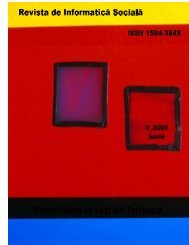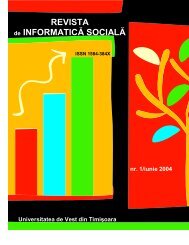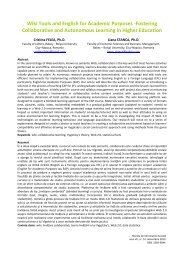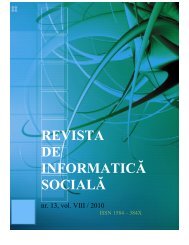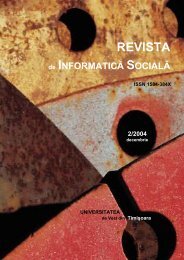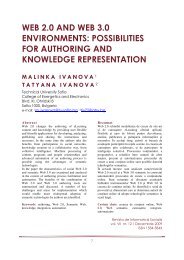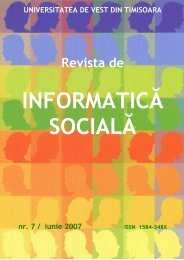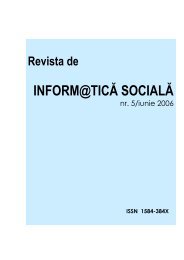No 14 - Journal of Social Informatics / Revista de Informatica Sociala
No 14 - Journal of Social Informatics / Revista de Informatica Sociala
No 14 - Journal of Social Informatics / Revista de Informatica Sociala
You also want an ePaper? Increase the reach of your titles
YUMPU automatically turns print PDFs into web optimized ePapers that Google loves.
that they can get a college-graduate-caliber job and add value in it. Post recession, all U.S. highereducation needs to adopt and scale these practices.Transformed Online Learning is a Part <strong>of</strong> Broa<strong>de</strong>r Institutional StrategiesInstitutional lea<strong>de</strong>rs spent 2008 and 2009 “staunching the flow” <strong>of</strong> the resource impact <strong>of</strong> the GreatRecession. They recognize that they must use 2010-2012 to aggressively leverage stimulus fundingand discover not just efficiencies, but innovations and transformations that will make their coursesmore attractive to stu<strong>de</strong>nts and will enable them to achieve financial sustainability when thestimulus money is gone. Transformed online, blen<strong>de</strong>d and e-learning is one <strong>of</strong> a set <strong>of</strong> even broa<strong>de</strong>rinstitutional strategies to achieve financial sustainability that are mentioned in the white paper,“Linking Analytics to Lifting out <strong>of</strong> Recession.” [6]Jobs, Jobs, Jobs<strong>No</strong>t enough online courses make explicit the links between the content and methods <strong>of</strong> the course,the metaskills honed in the course (learning to learn) and the requirements <strong>of</strong> organizations that mayhire graduates from that course. Faculty should give thought to this. One possible solution is to setup an online discussion space for current stu<strong>de</strong>nts to hear from stu<strong>de</strong>nts in a previous cohort.Another solution is to link stu<strong>de</strong>nts to pr<strong>of</strong>essional communities, so that they can find out how tomake themselves more employable. The general rule is that learning experiences must be moreclosely linked to active, immersive application and to the future workplace. The capacity toperpetually enhance competences and meta-skills to maintain or raise competitiveness is enhancedwith online learning and Web 2.0 tools and patterns <strong>of</strong> interactivity. The building <strong>of</strong> job-relatedcompetences, using online learning and related agile organizational capacities, is likely to be a highpriority in the near-term future and beyond.As we look at the potential <strong>of</strong> online learning and competence building, we should learn frommarket lea<strong>de</strong>rs how to leverage transformation in business mo<strong>de</strong>ls and learning settings, as<strong>de</strong>scribed below.TWO TRANSFORMATIONS IN THE MODELS OF LEARNING AND COMPETENCEBUILDINGIn studying the strategies and actions <strong>of</strong> the market lea<strong>de</strong>rs, one should examine twotransformations that are ongoing and interconnected. These involve the business mo<strong>de</strong>ls andlearning settings <strong>of</strong> online learning. In our view, these dimensions are un<strong>de</strong>rgoing transformationsthat will shake higher education’s world unless institutions take advantage <strong>of</strong> the neworganizational capacities associated with e-learning.First, there is the evolution <strong>of</strong> the business mo<strong>de</strong>ls for institutions and formal learning enterprisesfrom today’s traditional premium price mo<strong>de</strong>l (bundled learning, assessment and certification; afocus on what constitutes a quality education/institution; and traditional roles for faculty) to atransformed mo<strong>de</strong>l (unbundled and re-imagined teaching, learning, assessment and certification;value-based in times <strong>of</strong> scarce resources; re-invented roles for faculty, mentors, instructional<strong>de</strong>signers and peer-to-peer learning; and changing the financial mo<strong>de</strong>l to achieve financialsustainability and lower prices to the consumer).Second, there is the evolution <strong>of</strong> the learning setting from the traditional institutional setting to atransformed, open setting in which “open” inclu<strong>de</strong>s but is not limited to Open EducationalResources (OER) and related resources and practices. Open also means that users have far morechoice today about what they learn (not just prescribed learning pathways, but selected knowledgegaps, based on flows <strong>of</strong> continuously refreshed knowledge), how they learn it, what if anything theypay for it, and who they learn it with/from (e.g. peer-to-peer learning and community <strong>of</strong> practicebasedlearning). Open can mean a combination <strong>of</strong> “free” and “pay a fee.”



